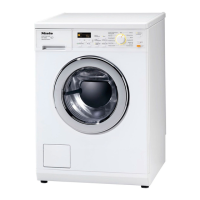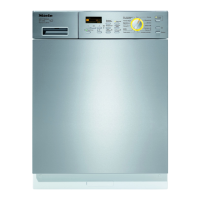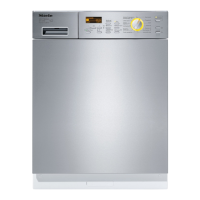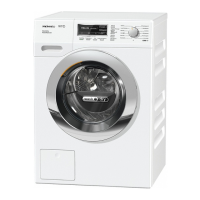Do you have a question about the Miele WT 2780 WPM and is the answer not in the manual?
Defines the intended domestic use and limitations of the washer-dryer to prevent improper operation.
Crucial guidelines to keep children safe around the appliance and prevent misuse.
Essential checks for electrical safety, earthing, and authorised repairs to prevent hazards.
Important usage rules, including temperature limits, foreign object prevention, and fire risk avoidance.
Lists items that must not be dried to prevent fire or damage, such as unwashed or chemically treated items.
Warnings about cooling phases, oil-affected items, and dye usage to prevent fire and damage.
Guides through setting the machine's language and current time of day for proper operation.
Crucial step to prevent damage by removing transport bars before the first use.
Instructions for running the initial wash programme and calibrating the load sensor.
A comprehensive table detailing programmes, temperatures, loads, and available extra options.
A table outlining drying programmes, suitable fabrics, maximum loads, and available extras.
Guides on running wash and dry cycles consecutively for optimal efficiency and load management.
Explains common fault messages and their remedies, such as drainage or water intake errors.
Solutions for problems like poor cleaning, greasy residues, or white marks on laundry.
Guidance for resolving issues like damp laundry, laundry being too dry, or hard textures.
Troubleshooting steps when the drum door cannot be opened, including safety locks and temperature checks.
Detailed steps for removing transit fittings before use and refitting them for relocation.
Guidance on connecting the machine to water and drainage systems safely and correctly.
Essential information on safe electrical hook-up, including earthing and RCDs.
Defines the intended domestic use and limitations of the washer-dryer to prevent improper operation.
Crucial guidelines to keep children safe around the appliance and prevent misuse.
Essential checks for electrical safety, earthing, and authorised repairs to prevent hazards.
Important usage rules, including temperature limits, foreign object prevention, and fire risk avoidance.
Lists items that must not be dried to prevent fire or damage, such as unwashed or chemically treated items.
Warnings about cooling phases, oil-affected items, and dye usage to prevent fire and damage.
Guides through setting the machine's language and current time of day for proper operation.
Crucial step to prevent damage by removing transport bars before the first use.
Instructions for running the initial wash programme and calibrating the load sensor.
A comprehensive table detailing programmes, temperatures, loads, and available extra options.
A table outlining drying programmes, suitable fabrics, maximum loads, and available extras.
Guides on running wash and dry cycles consecutively for optimal efficiency and load management.
Explains common fault messages and their remedies, such as drainage or water intake errors.
Solutions for problems like poor cleaning, greasy residues, or white marks on laundry.
Guidance for resolving issues like damp laundry, laundry being too dry, or hard textures.
Troubleshooting steps when the drum door cannot be opened, including safety locks and temperature checks.
Detailed steps for removing transit fittings before use and refitting them for relocation.
Guidance on connecting the machine to water and drainage systems safely and correctly.
Essential information on safe electrical hook-up, including earthing and RCDs.
| Door hinge | Right |
|---|---|
| Water fill | Cold |
| Display type | - |
| Loading type | Front-load |
| Product color | White |
| Built-in display | Yes |
| Appliance placement | Freestanding |
| Drying capacity | 3 kg |
| Washing capacity | 5.5 kg |
| Delay start (max) | 24 h |
| Residual moisture | 44 % |
| Maximum spin speed | 1600 RPM |
| Number of drying programs | 25 |
| Washing class | A |
| Annual water consumption washing | 9000 L |
| Annual energy consumption washing | 186 kWh |
| Annual water consumption washing & drying | 13800 L |
| Annual energy consumption washing & drying | 748 kWh |
| Current | 10 A |
| AC input voltage | 220 - 240 V |
| AC input frequency | 50 Hz |
| Water consumption washing per cycle | 45 L |
| Energy consumption washing per cycle | 0.93 kWh |
| Water consumption washing & drying per cycle | 69 L |
| Energy consumption washing & drying per cycle | 3.74 kWh |
| Depth | 595 mm |
|---|---|
| Width | 580 mm |
| Height | 850 mm |
| Weight | 101000 g |
| Depth with door open | 957 mm |











